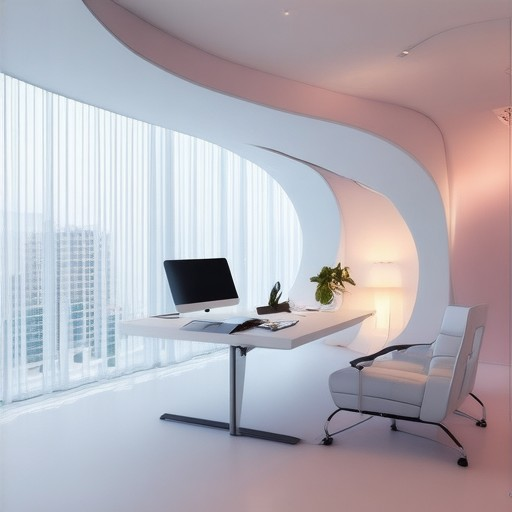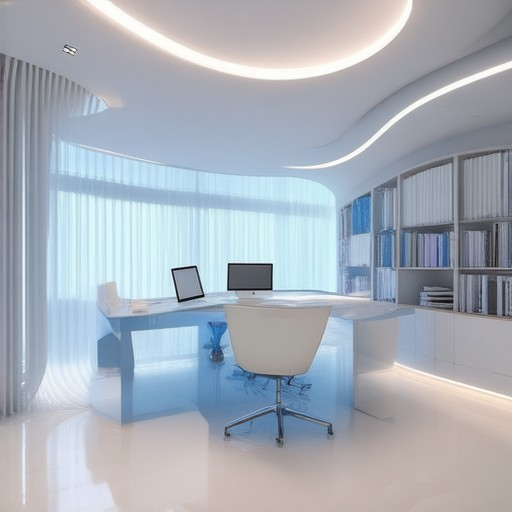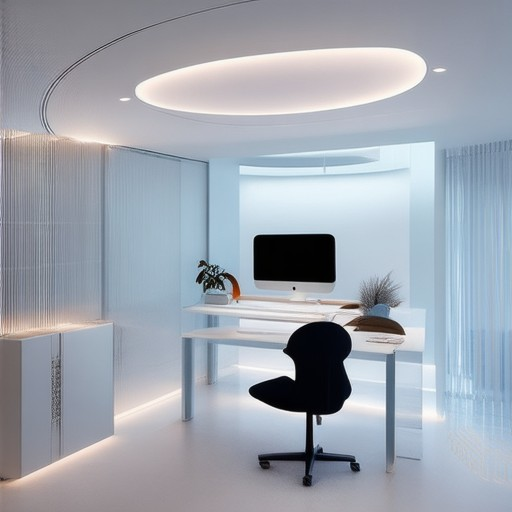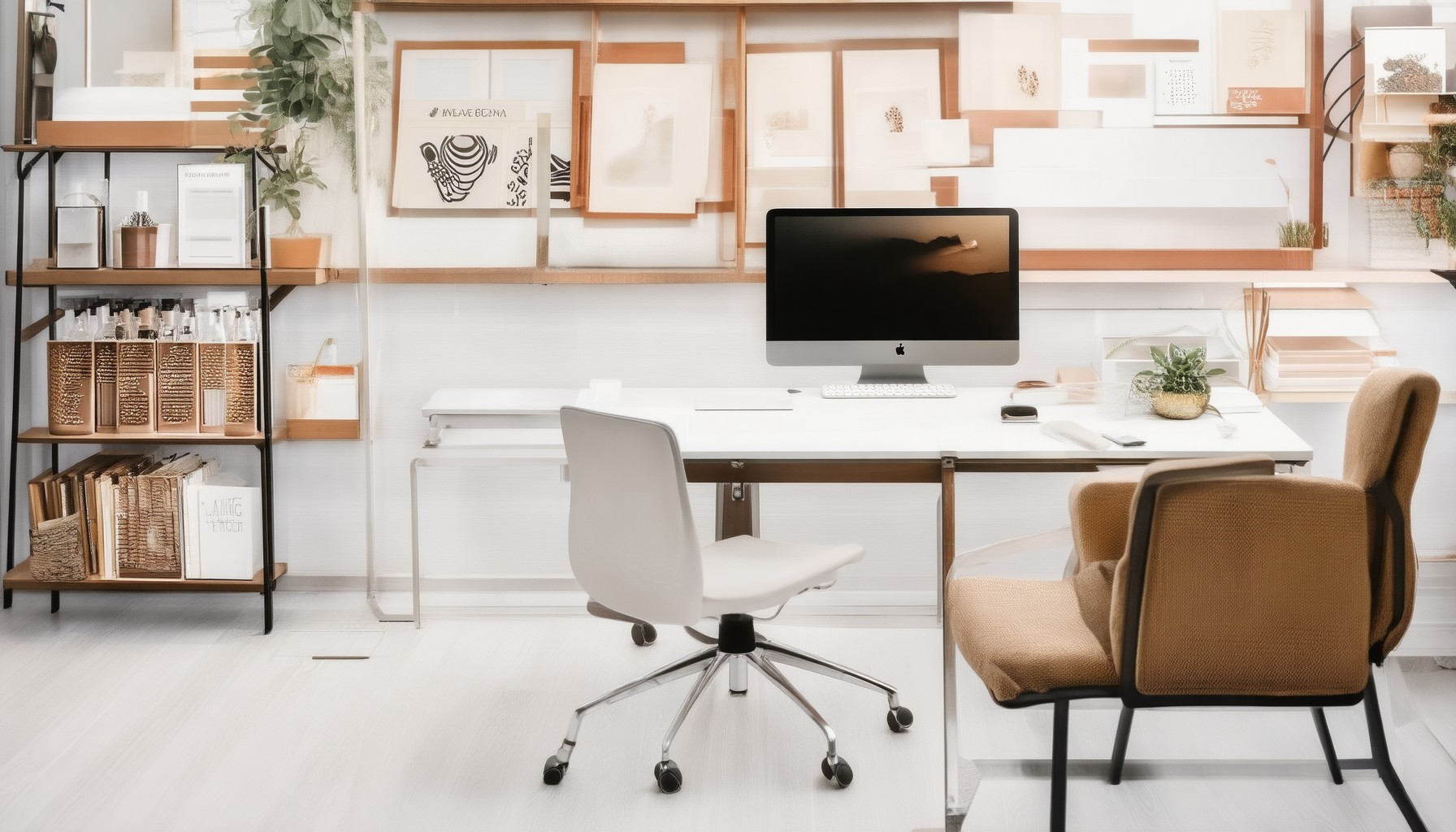Creating the perfect home office space is a challenge many of us face, especially when balancing functionality with style. One of the most common questions is whether a desk should face the wall or the window. While traditional setups often prioritize focus, modern designs increasingly blend functionality with aesthetics. Whether you’re working in a cramped corner or a spacious room, optimizing your home office space is key to productivity and comfort. From small home office ideas to modern designs, there are countless ways to transform even the tiniest of spaces into a functional workspace. Discover how to maximize efficiency with ergonomic furniture, explore space-saving tips, and stay ahead of trends like biophilic design and modular systems. With the right approach, your home office can become not just a place to work but a sanctuary for creativity and focus.

How to Face Your Home Office Desk for Maximum Productivity
When setting up your home office, the orientation of your desk plays a crucial role in creating a comfortable and efficient workspace. Here’s a step-by-step guide to determining the optimal direction for your desk:
- Consider Your Workspace Layout:** Begin by evaluating the layout of your room. If you have limited space, choose a compact desk that fits well.
- Choose Ergonomic Posture:** Opt for a desk that allows you to sit in a neutral position, ensuring your neck, shoulders, and wrists remain relaxed during long hours of work.
- Check Ceiling Height:** Measure the height of your ceiling to ensure there’s enough clearance for overhead storage or lighting fixtures.
- Ensure Proper Lighting:** Position your desk near natural light or ensure artificial lighting provides adequate illumination without causing eye strain.
For the most ergonomic setup, consider the following desk orientations:
- Desk Facing the Wall:** This traditional setup is ideal for those who prefer a clutter-free environment and easy access to wall-mounted items like shelves and cables.
- Desk Facing the Window:** Placing your desk by a window can reduce eye strain and offer a refreshing view, though ensure your screen isn’t directly facing the sunlight to prevent glare.
- Corner Desk Setup:** Utilize a corner desk to save space and maximize functionality, ensuring it faces the wall to keep your workspace organized.
Remember to evaluate your desk setup regularly to ensure it supports your ergonomics and productivity needs. By thoughtfully choosing the right orientation, you can create a tailored workspace that enhances your workflow and overall comfort.
Creating a Productive Home Office
Transforming a space into a functional home office requires careful planning and thoughtful organization. Below are key steps and considerations to help you maximize productivity:
1. Organize Your Space
- declutter: Clear out unnecessary items to create a clean and clutter-free environment.
- use storage solutions: Implement drawer organizers, shelves, or cabinets to keep supplies neatly stored.
- label everything: Use clear labels to easily identify items, reducing the time spent searching for what you need.
2. Optimize Comfort and Ergonomics
- ergonomic furniture: Invest in an adjustable chair and a desk that allows for proper posture and comfortable seating.
- adjustable desk: Consider a stand-up desk to alternate between sitting and standing throughout the day.
- proper lighting: Use task lighting for focused work and ambient lighting to create a balanced illumination in the room.
3. Control Noise and Distractions
- noise reduction: Use noise-canceling headphones or invest in soundproofing materials to minimize external distractions.
- plants for absorption: Incorporate plants like succulents or snake plants to help absorb noise and improve air quality.
4. Furniture Arrangement
- create a dedicated workspace: Set aside a specific area for work, free from personal activities to mentally transition out of work mode.
- use a small table or desk: Even a compact setup can be highly effective if organized properly.
5. Enhance Motivation and Mood
- add plants: Greenery can boost mood and concentration, making the space feel more inviting.
- consider color scheme: Use calming colors like blue or green to enhance focus and productivity.
6. Establish a Routine
- set a consistent schedule: Define specific work hours and stick to them to maintain discipline.
- use time management techniques: Try the Pomodoro Technique or time-blocking to stay on track.
7. Take Regular Breaks
- incorporate micro-breaks: Stand up, stretch, or take a short walk every 25-30 minutes to refresh your mind.
- avoid burnout: Regular breaks can help maintain energy levels and prevent mental fatigue.
8. Stay Connected and Organized Digitally
- use project management tools: Tools like Trello or Asana can help manage tasks and deadlines effectively.
- organize files: Create a structured file system on your computer to keep documents and projects accessible yet organized.
By implementing these strategies, you can create a home office that is not only functional but also inspiring and conducive to productivity.

What is an ideal home office setup?
An ideal home office setup involves creating a functional, comfortable, and organized space tailored to your specific needs. Below are the key components to consider:
- Workspace Setup:
- Choose a dedicated area free from distractions.
- Opt for a comfortable chair and sturdy desk, ensuring proper posture and ergonomic alignment.
- Use a clean, clutter-free surface to enhance focus and efficiency.
- Seating and Ergonomics:
- Invest in an ergonomic chair to support proper spinal alignment and reduce muscle strain.
- Consider an adjustable standing desk to promote better circulation and reduce sedentary habits.
- Ensure your monitor is at eye level and positioned directly in front of you to minimize neck strain.
- Lighting:
- Utilize natural light during the day to boost productivity and mood.
- Incorporate task lighting, such as a desk lamp, for focused work environments.
- Avoid harsh fluorescent lights to reduce eye strain.
- Organization Tools:
- Use drawer organizers, shelf units, and file cabinets to keep supplies tidy.
- Implement a trash bin or recycling container within easy reach.
- Consider wall-mounted storage solutions to maximize space efficiency.
- Technology Integration:
- Ensure your computer, printer, and other devices are connected via reliable Wi-Fi or Ethernet.
- Use noise-canceling headphones to block out external distractions.
- Install necessary software applications for productivity and collaboration.
- Ergonomic Accessories:
- Add a comfortable mouse pad and an anti-fatigue mat to reduce strain during long work sessions.
- Use a document holder or notebook arm to keep supplementary materials close at hand.
- Personalization:
- Decorate your space with calming colors or artwork to create a welcoming environment.
- Include plants or greenery to improve air quality and reduce stress.
- Adjust the layout to suit your workflow preferences, whether it’s a traditional desk setup or a standing counter.
- Noise Management:
- Use acoustic panels or white noise machines to dampen sound reflections.
- Position your desk away from windows or doors to minimize interruptions.
- Employ soft flooring options to absorb footstep sounds.
- Productivity Routine:
- Establish a consistent daily schedule to maintain focus and discipline.
- Keep a planner or digital calendar visible to track deadlines and priorities.
- Create a dedicated workspace for tasks requiring deep focus, such as meditation or creative projects.
By thoughtfully organizing your home office setup, you can optimize productivity, comfort, and overall well-being.

Home Office Trends for 2025
We’ve compiled a list of the most anticipated home office trends for 2025, focusing on innovation, productivity, and comfort.
1. Enhanced Technology Integration
In 2025, home offices will embrace seamless technology integration. Expect:
- AI-powered productivity tools for task management and time tracking
- Smart home devices that adapt to your workflow (e.g., voice-activated assistants for hands-free multitasking)
- Virtual desktops and cloud-based solutions for easier collaboration
2. Sustainability Meets Productivity
With a growing emphasis on eco-friendliness, sustainable home office designs will dominate. Key features include:
- Eco-friendly furniture and materials made from recycled materials
- Energy-efficient lighting and appliances to reduce environmental impact
- Plants and greenery to boost mental well-being while promoting a healthy work-life balance
3. Collaboration Tools Redefined
Remote work continues to shape the home office landscape. Here’s what’s next:
- Advanced video conferencing tools with augmented reality features
- Cloud-based document sharing platforms with real-time editing capabilities
- Virtual whiteboards and collaborative note-taking apps
4. Personalized Workspaces
Customizable home offices will be the norm in 2025. Users will prioritize:
- Flexible layouts tailored to individual needs
- Ergonomic adjustments for improved comfort
- Color-coded zones for different tasks (e.g., creative work vs. administrative tasks)
5. Blended Work-Life Balance
Designers are focusing on creating spaces that inspire productivity while fostering relaxation. Key elements include:
- Calming color palettes to reduce stress
- Soundproofing solutions for focused work environments
- Spaces for mindfulness and meditation
6. Smart Automation
Smart home automation will revolutionize daily routines. Features expected to emerge include:
- Automated lighting schedules based on your work hours
- Smart temperature control to maintain optimal working conditions
- Integrated security systems for added peace of mind
These trends reflect a shift toward creating versatile, efficient, and inspiring home offices that cater to both personal and professional needs. By staying ahead of these design and technological advancements, you can stay productive and comfortable in your workspace for years to come.
What is the furniture trend in 2025?
The furniture landscape in 2025 is characterized by a blend of innovation, sustainability, and personalization. Designers predict several key trends that will shape the look and feel of interiors.
Sustainable Design
Eco-consciousness continues to influence furniture design, with a focus on materials like reclaimed wood, recycled metals, and organic fabrics. Brands are prioritizing ethical production practices, making sustainable options more mainstream.
Modular and Flexible Furniture
Furniture that adapts to changing spaces is gaining popularity. Modular pieces allow for easy rearrangement, making homes more versatile for different activities. This trend supports multi-functional living spaces.
Biophilic Design
Bringing elements of nature indoors remains a significant trend. Designers are incorporating natural textures, soft curves, and calming color palettes to create spaces that promote mental well-being.
Customization and Personalization
Homeowners are seeking unique solutions that reflect their personal style. Customizable furniture options, from bespoke upholstery to tailored storage solutions, are becoming more accessible and affordable.
Technology Integration
Smart furniture is expected to dominate, with built-in sensors, voice controls, and automated functions. This trend aligns with the growing demand for convenience and efficiency in modern lifestyles.
For more insights and design inspiration, explore Peck and Gartner , your trusted source for home improvement and interior design trends.

What Does the Future of Office Space Look Like?
The future of office space is evolving rapidly, driven by changing workforce demands, technological advancements, and shifting business priorities. Here’s a breakdown of what lies ahead:
Hybrid Work Models and Remote Capabilities
Offices will likely adopt hybrid models, blending in-office and remote work environments. Companies are expected to invest in flexible office spaces that support both collaborative and individual work styles. Technologies like virtual desktop infrastructure and cloud-based tools will play a crucial role in enabling remote access to office resources.
Flexible Office Designs
Offices will become more adaptable, featuring modular furniture and adjustable layouts to accommodate varying team sizes and work needs. Desk-sharing systems and hot-desking solutions will remain popular, allowing employees to reserve workspace as needed. Additionally, micro-offices and private booths will be integrated to support focused work and collaboration.
Technology Integration
Smart offices will dominate the landscape, utilizing IoT-enabled devices for lighting, temperature control, and security. Virtual assistant kiosks and automated systems will streamline administrative tasks, freeing up staff for more strategic work. Advanced conferencing tools like Zoom and Microsoft Teams will continue to enhance remote and in-person interactions.
Sustainability and Eco-Friendly Features
Environmental responsibility will shape office design. LEED certification, green walls, and energy-efficient lighting will be standard features. Offices will also incorporate biophilic elements, such as indoor gardens and natural light, to promote well-being. Water-saving fixtures and waste reduction programs will further contribute to sustainability efforts.
Collaboration and Community Spaces
Offices will prioritize collaboration hubs, such as innovation labs and co-working spaces, to foster creativity and teamwork. These areas will often be equipped with cutting-edge tools and will host regular workshops and events. Social spaces will encourage networking and camaraderie among employees.
Conclusion
The future office will be a dynamic, tech-driven environment that supports both productivity and well-being. By embracing flexibility, sustainability, and advanced technologies, organizations can create spaces that meet the needs of a diverse workforce while remaining competitive in a rapidly changing world.
- Explore smart home innovations that could influence office design.
- Discover sustainable living tips relevant to office spaces.
- Learn about modern interior design trends shaping office environments.





0 Comments